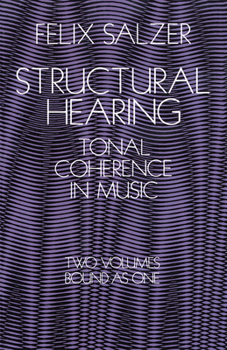Structural Hearing: Tonal Coherence in Music
Select Format
Select Condition 
Book Overview
Written by a pupil of the late Heinrich Schenker, this outstanding work is the most thorough exposition in English of Schenker's work. Developing and extending the Schenker approach to include modern music, it explores the phenomenon of tonal organization in Western music by means of a detailed analysis and discussion of more than 500 musical examples ranging in time from the Middle Ages to such moderns as Bartok, Hindemith, Prokofiev, and Stravinsky.
Heinrich...
Format:Paperback
Language:English
ISBN:0486222756
ISBN13:9780486222752
Release Date:June 1962
Publisher:Dover Publications
Length:688 Pages
Weight:1.05 lbs.
Dimensions:1.3" x 5.3" x 8.6"
Customer Reviews
5 ratings
Quintessential Schenkerian Theory
Published by Thriftbooks.com User , 19 years ago
For anyone interested in Tonal Theory this work is absolutely necessary. Salzer's work is a continuation & extrapolation on Heinrich Schenker's work on music theory. The only drawback is it is not fully consistent when dealing with post-Romanticism (but then Schneker's theory is not always applicable in later musical contexts, & in some cases not completely internally-consistent). However, for the foundations of music from Bach to Beethoven ( & the Romantic composers afterward as well as any modern composition even remotely tonal) it is a masterwork.
Excellent Book!, but try rebinding it.
Published by Thriftbooks.com User , 20 years ago
This is a great book for those interested in exploring the many and varied aspects and ramifications of Schenkerian theory. I first bought this book in its hardback-two-separate-volume edition in 1972 or 1973, when, as an undergraduate music student, I was looking for answers to how music "works." This was while studying at a university where the music theory department had been commandeered by a couple of "avant-gardiste" professors who, after eliminating all traditional harmony classes,further insisted that all students should compose, regardless of interest or ability, and that atonality, interminable dissonance, and "originality" for its own sake be the ideals which one should be forced to uphold. It was in this environment that I began my search for musical understanding, and started researching the theoretical, harmonic, contrapuntal, and formal aspects of music that were so sorely neglected in my university education. It was at this time that I became aware of the book "Structural Hearing." In fact, one friend of mine told me, that this was the best book on theory that he had ever read. There are three things I would recommend to anyone interested in studying this book: 1. First, understand the basics of 4-part harmony, and become proficient at reading figured bass notation. This will help you understand the sections of the book that deal with what the author refers to as "chord grammar." 2. Second, get a copy of "The Study of Counterpoint," by J. J. Fux. This is the Norton edition of the translation of the famous "Gradus ad Parnassum." Work through the exercises in this book. In addition to being a lot of fun, these exercises will teach you a ton about the origins of harmony, voice leading, etc., and will provide some amazing practical solutions to problems you may encounter later, in composing original music, and/or arranging. I have always been happy for the work I did in this book. Trust me, you won't regret it! 3. Go to the nearest print shop that does book binding. They can split your book into two volumes, laminate the covers of them, and spiral bind each section. This will allow you to have the text and the examples side by side, and, as they are spiral bound, will allow you to lay them out flat. I do this with almost all of the scores, or music books with which I work. I recommend this to the reviewer above who expressed regret that the book was bound as a single volume, as well as all others who study this book. I am delighted to get this book in the paperback edition, and I hope my recommendations are helpful.
GREAT book, but get an older copy
Published by Thriftbooks.com User , 23 years ago
This comment has more to do with the format of the Dover reprint than it does with the actual text. In the older edition of "Structural Hearing" the text was in volume one and the examples were in volume two. This allowed the reader to have the examples in front of them to refer to while they read the text. The Dover reprint is essentially both volumes bound into one book. This causes the book to be very cumbersome, although it probably significantly lowers the production cost. When I read "Structural Hearing" I finally had to check out volume two from the university library. I sincerely hope that the new Longman edition of "Der Frei Satz" maintains the original format.
Brilliant!
Published by Thriftbooks.com User , 24 years ago
This is the best book to help anyone understand the tonal coherence in classical music. It takes you through counterpoint, harmony and analysis. If your goal is to comprehend Schenkerian Analysis, then this is the book you are looking for.I am wondering if there are any performers out there studying this book. If you are one of them, please write to me at: lan_qiu@hotmail.com. I'd love to hear from you. I am a performer currently studying this book by myself and would like to know how this book has helped you so far.
Simply the Best!
Published by Thriftbooks.com User , 25 years ago
This book is the best introduction to the theories of Schenker that I've ever read. It is simple, concise and easy to understand. It also serves as a good advanced musicianship book dealing with species counterpoint. It deals with music from the Renaissance to the twentieth-century which is quite refreshing. Recommended.




